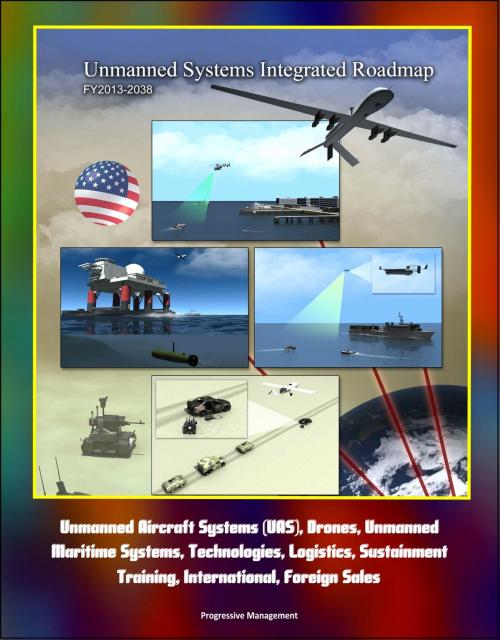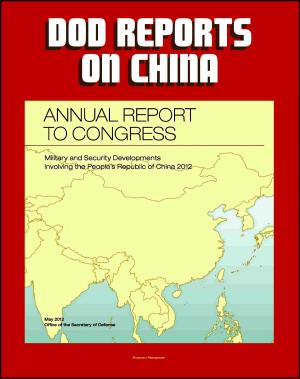Unmanned Systems Integrated Roadmap FY2013-2038 - Unmanned Aircraft Systems (UAS), Drones, Unmanned Maritime Systems, Technologies, Logistics, Sustainment, Training, International, Foreign Sales
Nonfiction, Science & Nature, Technology, Aeronautics & Astronautics, History, Military, Aviation| Author: | Progressive Management | ISBN: | 9781310120633 |
| Publisher: | Progressive Management | Publication: | October 4, 2014 |
| Imprint: | Smashwords Edition | Language: | English |
| Author: | Progressive Management |
| ISBN: | 9781310120633 |
| Publisher: | Progressive Management |
| Publication: | October 4, 2014 |
| Imprint: | Smashwords Edition |
| Language: | English |
Unmanned systems continue to deliver new and enhanced battlefield capabilities to the warfighter. While the demand for unmanned systems continues unabated today, a number of factors will influence unmanned program development in the future.
The purpose of this Roadmap is to articulate a vision and strategy for the continued development, production, test, training, operation, and sustainment of unmanned systems technology across DoD. This "Unmanned Systems Integrated Roadmap" establishes a technological vision for the next 25 years and outlines actions and technologies for DoD and industry to pursue to intelligently and affordably align with this vision.
Chapter 1: Introduction — This chapter explains the Roadmap's purpose and scope. It examines the current unmanned environment from an inventory and budget perspective while also surveying the potential future environment. The chapter includes an operational vignette to show potential future capabilities using some of the technologies described later in this Roadmap.
Chapter 2: Strategic Planning and Policy — This chapter expounds on the structure, direction, and established guidance from DoD leadership toward planning and developing unmanned systems.
Chapter 3: CCDR Mission and Capability Needs — A joint perspective emerges in this chapter through a discussion of mission capabilities unique to unmanned systems and an explanation of the requirements process used to deliberately develop those capabilities to achieve improved efficiency, effectiveness, and survivability and to reduce the burden on manpower at lower costs while still meeting future operational requirements. The perspective establishes that future unmanned systems must
Provide capabilities more efficiently through such attributes as modularity, interoperability, integration with manned systems, and use of advanced technologies. Be more effective through features such as greater automation, improved performance, and flexible use of capabilities. Be more survivable in contested environments through improved and resilient communications, increased security from tampering, and system design.
Chapter 4: Technologies for Unmanned Systems — Certain key areas of interest for improving technology reflect DoD's shift in strategic priorities and address the requirement to continue to reduce lifecycle costs across all systems, including unmanned systems.
Chapter 5: Operating Environment — This chapter describes the operating environments of unmanned systems, which are critical in determining system performance flexibilities (e.g., appropriate levels of automation, maneuverability, communication options) needed to accomplish the mission.
Chapter 6: Logistics and Sustainment — The rapid development and fielding of large numbers and types of unmanned systems present DoD with a significant sustainment challenge. This chapter discusses the necessary transition from supporting immediate warfighter capability requirements to creating an affordable, long-term sustainment environment utilizing a flexible blend of original equipment manufacturers (OEM), other contractors, and organic support to meet logistics support objectives.
Chapter 7: Training — The current state and forces shaping the training environment are similar to those that have shaped the logistics environment.
Chapter 8: International Cooperation — This chapter reflects DoD's efforts to include cooperative research, development, test and evaluation, and regulatory/standard agreements of defense technologies and systems with foreign partners as well as the procurement of defense articles, systems, and services from foreign partners. DoD objectives and methods are explained.
Unmanned systems continue to deliver new and enhanced battlefield capabilities to the warfighter. While the demand for unmanned systems continues unabated today, a number of factors will influence unmanned program development in the future.
The purpose of this Roadmap is to articulate a vision and strategy for the continued development, production, test, training, operation, and sustainment of unmanned systems technology across DoD. This "Unmanned Systems Integrated Roadmap" establishes a technological vision for the next 25 years and outlines actions and technologies for DoD and industry to pursue to intelligently and affordably align with this vision.
Chapter 1: Introduction — This chapter explains the Roadmap's purpose and scope. It examines the current unmanned environment from an inventory and budget perspective while also surveying the potential future environment. The chapter includes an operational vignette to show potential future capabilities using some of the technologies described later in this Roadmap.
Chapter 2: Strategic Planning and Policy — This chapter expounds on the structure, direction, and established guidance from DoD leadership toward planning and developing unmanned systems.
Chapter 3: CCDR Mission and Capability Needs — A joint perspective emerges in this chapter through a discussion of mission capabilities unique to unmanned systems and an explanation of the requirements process used to deliberately develop those capabilities to achieve improved efficiency, effectiveness, and survivability and to reduce the burden on manpower at lower costs while still meeting future operational requirements. The perspective establishes that future unmanned systems must
Provide capabilities more efficiently through such attributes as modularity, interoperability, integration with manned systems, and use of advanced technologies. Be more effective through features such as greater automation, improved performance, and flexible use of capabilities. Be more survivable in contested environments through improved and resilient communications, increased security from tampering, and system design.
Chapter 4: Technologies for Unmanned Systems — Certain key areas of interest for improving technology reflect DoD's shift in strategic priorities and address the requirement to continue to reduce lifecycle costs across all systems, including unmanned systems.
Chapter 5: Operating Environment — This chapter describes the operating environments of unmanned systems, which are critical in determining system performance flexibilities (e.g., appropriate levels of automation, maneuverability, communication options) needed to accomplish the mission.
Chapter 6: Logistics and Sustainment — The rapid development and fielding of large numbers and types of unmanned systems present DoD with a significant sustainment challenge. This chapter discusses the necessary transition from supporting immediate warfighter capability requirements to creating an affordable, long-term sustainment environment utilizing a flexible blend of original equipment manufacturers (OEM), other contractors, and organic support to meet logistics support objectives.
Chapter 7: Training — The current state and forces shaping the training environment are similar to those that have shaped the logistics environment.
Chapter 8: International Cooperation — This chapter reflects DoD's efforts to include cooperative research, development, test and evaluation, and regulatory/standard agreements of defense technologies and systems with foreign partners as well as the procurement of defense articles, systems, and services from foreign partners. DoD objectives and methods are explained.















